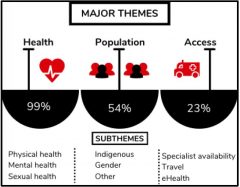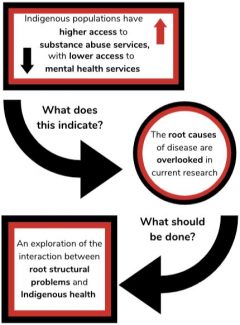Report – Rural Youth Health in Canada, Sweden, and Australia
Sinclair L, LeBlanc M, Sendanyoye C, & PA Peters. (2019). Rural Youth Health in Canada, Sweden, and Australia. Spatial Determinants of Health Lab, Carleton University: Ottawa, ON. DOI: 10.22215/sdhlab/2019.6
A high-quality PDF of this report with references is available for download.
The small size coupled with remoteness of rural communities in Canada, Australia, and Sweden introduce challenges in accessing sufficient health services (1-3). The sparse health services in rural areas impose “the tyranny of distance” on rural and remote populations, necessitating lengthy travel times to receive care. Despite the increased challenges rural communities face, a dearth of research on rural health persists, particularly rural youth health (4,5).
A broad scoping review was undertaken to identify literature regarding rural youth health in Canada, Australia, and Sweden. The studies were coded according to population focus, health focus, access, and general. The scoping review produced the Rural Youth Health Scoping Review Database, which provides an overview of the available research on rural youth health.
STATE OF THE RESEARCH

Physical health was researched most for rural youth, followed by mental health. Sexual health, substance use, and recreation were also included in studies, but were studied much less than the first two categories.
More than half of the articles included in the database focused on specific populations. Indigenous peoples and gender studies were the most prevalent categories, followed by refugees/immigrants, LGBTQ, and racism.
Codes related to access to care included travelling to receive healthcare, waitlists limiting access, recruitment and retainment of health care professionals, eHealth initiatives, and specialist availability. Specialist availability was the most studied category, with 71 articles mentioning specialists in the abstract. Travel and eHealth were also prevalent topics, with a smaller number of articles discussing waitlists and recruitment and retention.
INDIGENOUS HEALTH STUDIES
In the Canadian territories, health outcomes and life expectancy decrease as the percentage of Indigenous people increases (2). In Nunavut, where Indigenous people make up 85% of the population, the life expectancy at birth is 11 years lower than the Canadian average (2). The most frequently studied subpopulation of rural populations are Indigenous populations. The health foci of studies in Indigenous populations differ from the general population.

A higher number of studies on substance abuse in Indigenous populations have been conducted compared to the general population, while the general population has an increased number of studies regarding mental health. The findings suggest that the root structural causes of health issues, such as racism and mental health, may not be sufficiently and properly studied (6,7). Additionally, although suicide is often portrayed in the Canadian media in reference to Indigenous youth and Indigenous communities, the rates of studies regarding suicide in Indigenous-specific abstracts and general abstracts are proportionally the same. In order to improve the current state of research regarding Indigenous youth health, an exploration of the interaction between root structural problems and Indigenous health should be conducted.